Intel Ghost Canyon NUC9i9QNX Review: NUC 9 Extreme Realizes the SFF Dream
by Ganesh T S on April 16, 2020 8:05 AM ESTBAPCo SYSmark 2018
The Intel NUC9i9QNX (Ghost Canyon) was evaluated using our Fall 2018 test suite for small-form factor PCs. In the first section, we will be looking at SYSmark 2018.
BAPCo's SYSmark 2018 is an application-based benchmark that uses real-world applications to replay usage patterns of business users in the areas of productivity, creativity, and responsiveness. The 'Productivity Scenario' covers office-centric activities including word processing, spreadsheet usage, financial analysis, software development, application installation, file compression, and e-mail management. The 'Creativity Scenario' represents media-centric activities such as digital photo processing, AI and ML for face recognition in photos and videos for the purpose of content creation, etc. The 'Responsiveness Scenario' evaluates the ability of the system to react in a quick manner to user inputs in areas such as application and file launches, web browsing, and multi-tasking.
Scores are meant to be compared against a reference desktop (the SYSmark 2018 calibration system, a Dell Optiplex 5050 tower with a Core i3-7100 and 4GB of DDR4-2133 memory to go with a 128GB M.2 SATA III SSD). The calibration system scores 1000 in each of the scenarios. A score of, say, 2000, would imply that the system under test is twice as fast as the reference system.
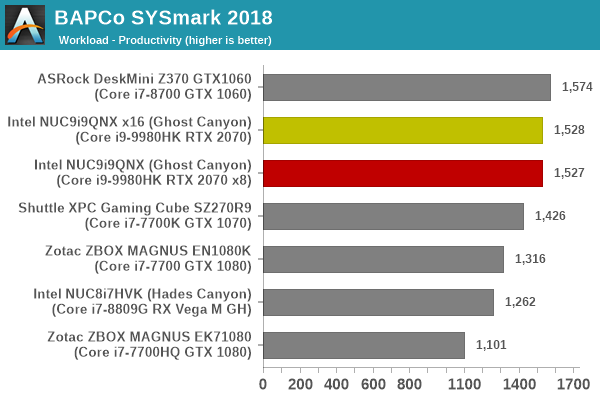
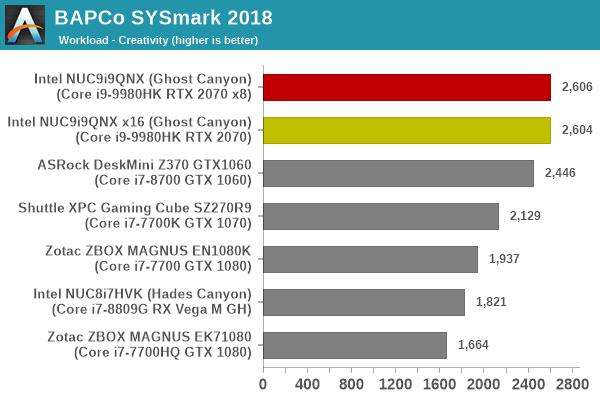
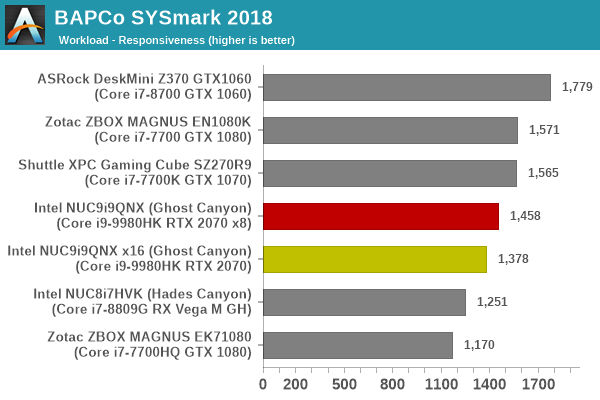
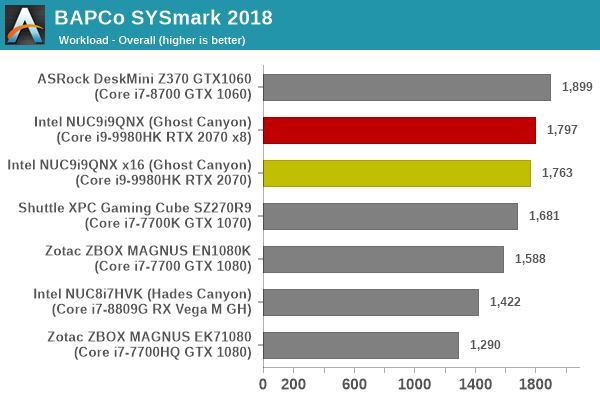
Systems equipped with 65W+ TDP desktop processors get higher scores in most workloads, though only the DeskMini Z370 manages an higher overall rating compared to the NUC9i9QNX. The surprising result is the responsiveness score for the two Ghost Canyon configurations - having the Optane drive talk directly to the CPU without the DMI bottleneck makes the system significantly more responsive.
SYSmark 2018 also adds energy measurement to the mix. A high score in the SYSmark benchmarks might be nice to have, but, potential customers also need to determine the balance between power consumption and the efficiency of the system. For example, in the average office scenario, it might not be worth purchasing a noisy and power-hungry PC just because it ends up with a 2000 score in the SYSmark 2014 SE benchmarks. In order to provide a balanced perspective, SYSmark 2018 also allows vendors and decision makers to track the energy consumption during each workload. In the graphs below, we find the total energy consumed by the PC under test for a single iteration of each SYSmark 2018 workload. For reference, the calibration system consumes 5.36 Wh for productivity, 7.71 Wh for creativity, 5.61 Wh for responsiveness, and 18.68 Wh overall.

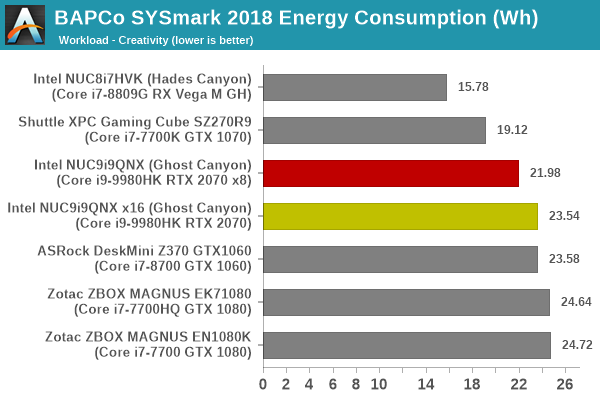
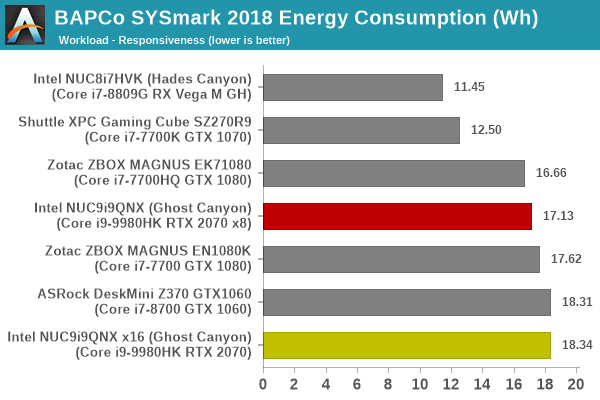
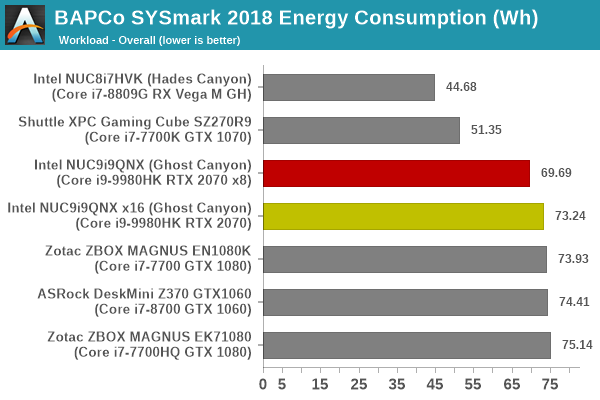
The NUC9i9QNX is hobbled slightly by the power-hungry Optane drive and high-TDP discrete GPU, making it approach the other desktop CPU-based systems in the list when the overall energy consumption is considered. Compared to a x16 configuration, operating the GPU at x8 results in lowered energy consumption for the SYSmark 2018 workloads.










109 Comments
View All Comments
fazalmajid - Sunday, April 19, 2020 - link
Yes. I wish they made the Mini in 3950X. If they can support the i9-9900K in the EliteDesk 800 G5 chassis (95W TDP), they should be able to support the 3950X as well, instead of the feeble Ryzen 5 that line tops out at.Namisecond - Monday, April 20, 2020 - link
AMD may not be able to meet the OEM demand for their 8-core and 16 core processors, whereas the 9900K may be plentiful.fazalmajid - Sunday, April 19, 2020 - link
I just got a HP EliteDesk 800 G5 with an i7-9700K and 64GB RAM, uncompromised 95W TDP in a smaller form factor (it’s for software development, so I don’t care about the GPU). You can even configure it with an i9-9900K and dual M.2 SSDs. It’s actually the fastest computer I own:https://browser.geekbench.com/v5/cpu/1826503
https://browser.geekbench.com/user/122632
henryjin - Sunday, April 19, 2020 - link
Surprised no mention here of the Velka 3 (https://www.velkase.com/products/velka-3) - full mini-ITX motherboard, flex-ATX power supply, and dual slot ITX graphics card in < 4 L.zodiacfml - Monday, April 20, 2020 - link
Weren't for Intel's NUCs being priceysjkpublic@gmail.com - Monday, April 20, 2020 - link
$1600? Really? Please give me a CPU without the spectre/meltdown microcode fixes and I may pay $500 for a NUC.mikato - Tuesday, May 5, 2020 - link
I see some neat boutique cases mentioned in comments that I haven't heard of before, but what about SFF cases that don't have support or more space for a discrete graphics card? I know that doesn't really match this review, but I'm interested in an SFF for an HTPC using integrated graphics. I don't think we need or want discrete graphics for watching TV.Also, I'll mention I only saw 3 lines of text from the article initially when going to a new article page. That bottom horizontal ad is huge. Come on.
tygrus - Thursday, May 7, 2020 - link
The Baseboard acts more like a PCIe riser connecting the ECE to the 3 slots sharing the 16 lanes (x16 or X8 + x4 + x4 NVMe).itsratso - Wednesday, July 29, 2020 - link
still waiting for the ability to power your computer on and off with my remote. you know like EVERY OTHER PIECE OF HT EQUIPMENT ON EARTH